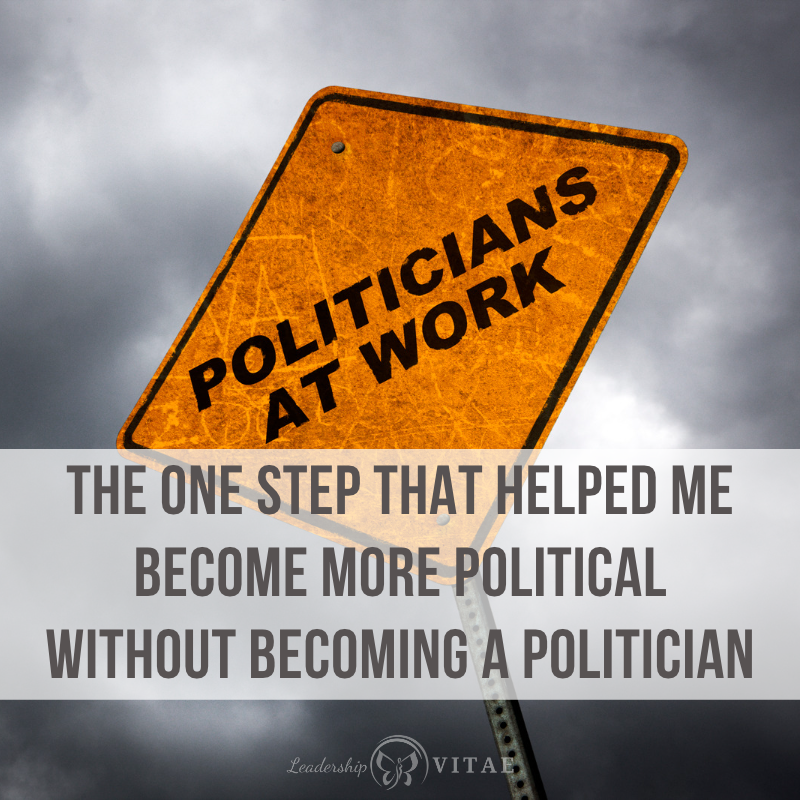
Feedback is a gift. Mostly.
While I am a firm believer that we can find goodness in most feedback we receive, sometimes it can be difficult to find. In the first role at my current organization, I was looking for input on how I could improve. What I heard was “you’re doing great.” While nice to hear, that doesn’t help anyone grow.
At one point, I received input on an improvement opportunity, but it didn’t feel actionable. The feedback was “you need to be more political.” Now, as a change leader I’d like to think that I’m not resistant to change. However, if you want to see me dig my heels in, the fastest way to do that is to tell me to be political.
And yet. What was the actionable insight? What could I take from this feedback? There was no chance I would become what I thought of as “a politician.” We all know them…the all show, no go types. The real question became how could I be more political, but still honor my leadership values?
Navigating conflicting feedback
It was not the first time I’ve received this feedback. I’ve also received the opposite feedback – that stakeholders appreciate my directness and genuine approach. That I have no agenda other than trying to do the right thing and put people first.
In that case, when feedback is conflicting, it’s time to consider the source. The folks that give the feedback to be more political tend to be more political themselves. They have stated and unstated agendas. Instead of focusing on people or doing the right thing, it might be on relationships or future opportunities.
Ironically, when there’s another goal, I have found that most folks are happy to help you get there. IF we have trusting relationships and we’re transparent. It’s the behind the scenes wheeling and dealing that can feel icky. When we all agree something makes sense, but we won’t even discuss it because it might risk a key relationship. Is it really a relationship if we can’t talk openly?
Ultimately, this all translated into figuring out how to build more relationships in a way that avoided the ick. Hearing “I need you to get closer to so and so”…NOPE. What was the no ick alternative?
Making feedback our own
To make feedback actionable and sustainable, we have to make it our own. What would it look like to integrate the input of others – whatever that feedback might be – into our own authentic approach?
Looking at patterns in the organization, it was clear what good relationships looked like. As were those that were without substance. We only have to look at what happens during change to know if a relationship is solid or not. Loose connections blow over in a strong wind. That’s true in work and in life.
We really learn what a relationship is made of when times get hard. Who do we tend to lean on and/or help when the seas are rough? Those we trust…and we tend to trust those we really know. AUTHENTICALLY.
So, surface-level connection wasn’t going to allow me to build the kind of relationships I wanted. That’s the fast path to being a politician. Instead, I could look for ways to build relationships that last. To do that, I needed to have a why.
The why is the reason we want to connect. Ideally one that is mutually beneficial.
Establish the why
As a change leader, my why is often obvious. Reaching out to customers and stakeholders, I ask questions to discover their pain points and aspirations. Why? So I can provide a quality product, service, or solution. When we center our customers, we achieve results that delight.
What if we are trying to build a relationship with someone that isn’t directly related to our work? First, consider why.
Maybe the answers are self-centered. To help build our career. Be the voice of support at decision-making tables. Or because we know they are going places and we want them to take us with them.
We can start with self-centered goals, but those aren’t going to build strong relationships. Not unless we flip it. Consider what the other person may gain from the relationship in return.
In discussions with fellow executives, we suspect when someone wants something from us simply due to our position. We may be happy to engage and help, but not thrilled when it feels transactional or we’re a means to an end.
To build strong relationships, the why should be bi-directional. Something that will provide both parties with value. Not in a tit-for-tat kind of way, but in the feeling of reciprocity to ensure it’s not solely one-sided.
Bi-directional relationships that last
During coaching conversations, I’m often asked about networking. Historically, I’ve thought of it as my kryptonite, that’s evolved over the years. Now I know that networking – the way most people do it – is a big ick because it feels one-sided. Each person trying to figure out what they can GET.
Trusting relationships start by considering what we can GIVE.
As I have been more intentional about relationship building over the last year plus, there’s been a clear why. Why this person and not that one? Then the next step is to figure out what I can offer to the relationship. It might be my work product. If not, then maybe I don’t have anything to give right out the gate, but I am certain to find ways to give after that first discussion.
When we meet with someone, we can let them know how we used the information from the discussion. Maybe it helped us get a new role, move a product forward, or solve a sticky problem. In my case, maybe it inspired an article and I’ll send over a link to it.
We can also be curious and ensure we center the other person at some point in the conversation. No matter our level or years of experience, we all have something to give. Maybe we have a fresh perspective because we are new. Or we’re at a level that may rarely be open about the opportunities and challenges being faced to those above us.
It doesn’t have to be a big give to show we aren’t just there to take.
Political, not a politician
The feedback to be more political was to help me achieve a career goal to move into a new people-centered role. The recommendation was to come up with a list of people that could help me and start engaging them to build relationships. That’s not what I did.
Instead, I looked for ways to help the organization in the areas I’m passionate about: coaching, leadership development, and all things change. As I raised my hand, I meet new people. They got to see my energy and passion first-hand. Invariably, they’d ask why I was in tech when I had such a passion for people. That’s when I’d share my interest in a role change and ask for any insight they might have on how to get there.
When the time came for a new opportunity, those same people were advocates and references. Not because I asked them to be or knew they would be approached. That’s the ultimate goal of strong relationships…people that know us and want to help because they know we have and would do the same.
When we give first and let people see who we are, they are more inclined to help. If we lead with what we want, we’re less likely to get it because we’re focused on outcomes. When we focus on people, they help us get to those outcomes.








